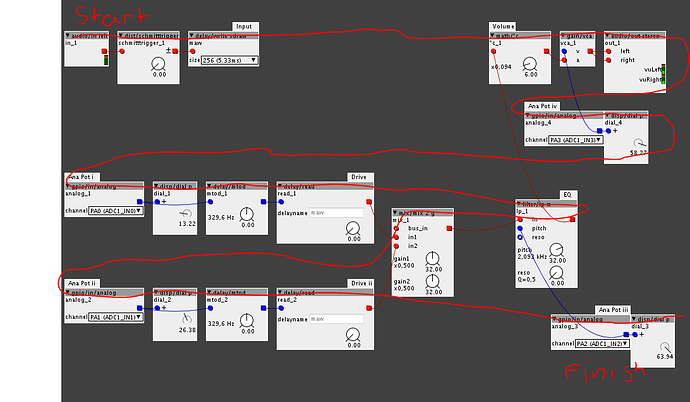Hi guys,
Here's a patch inspired by the awesome Zvex Wooly Mammoth fuzz pedal for our beloved Axolotii. I've experimented a lot with the 40106 IC which is a schmitt trigger, to make oscillators/synths, wild distortions... So i hoped it could work that way with the axoloti. Thanks for your schmitttrigger @johannes, it was a very nice surprise!
Today i soldered a few potentiometers (some oldschool B5k and B50k both work like a charm, i tried B100k as well, but it didn't reach the maximum range) to the axoloti to see how it worked, i wanna say thanks to all of you who posted questions, it helped me greatly to get the hang of it, so i left the gpios, just replace them with the ones you use.
4 controls:
(PAO and PA1)
Drive 1 // Drive 2: both are reading a delay line, with these two controls you can create tons of different kind of fuzz / high gain distortions. Very authentic/usable sounds, not noisy, but i wish i could add a little noise gate at the end, but i didn't know how to do it.
(PA2)
EQ: the pedal has the same kind of 1st order LP filter.
(Edit: i know i didn't use a 1st order LP here lol, it's only because it was the LP which came first)
(PA3)
Volume: output volume, adjust to match your ideal gain staging.
I tried the patch with an 8 string guitar, it should work for both bass and guitar, and i'm sure all kind of sources as well.
I'll try to make other patches with a 'guitar/bass pedal' approach in the future!
Have fun!
Flo
flo x mammoth fuzz.axp (6.7 KB)
Edit 2: here's an audio demo of the patch with an 8 string guitar:


 The delays are unnoticeable when you play directly thru the patch, so it's all good to me! But as i said in my first post (shoegaze chorus), i'm really not a master of it at all, and i'm really taking all possible advices you guys can give me. I'm an experienced producer who knows which final sound i want, so i chase that, and make it work with the programming, and if something can go 'wrong' i'll be pretty happy, if it's usable and expressing an emotion / energy, i'll take it over anything 'regular'!
The delays are unnoticeable when you play directly thru the patch, so it's all good to me! But as i said in my first post (shoegaze chorus), i'm really not a master of it at all, and i'm really taking all possible advices you guys can give me. I'm an experienced producer who knows which final sound i want, so i chase that, and make it work with the programming, and if something can go 'wrong' i'll be pretty happy, if it's usable and expressing an emotion / energy, i'll take it over anything 'regular'! 
 thank you!!
thank you!!